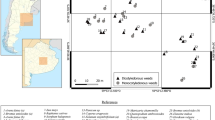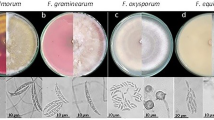Abstract
Potato Wilt is a common disease usually caused by either Verticillium dahliae or a Fusarium spp. In this study, we isolated and identified pathogens from diseased plants which were collected from different potato production areas along the foothills of Yinshan Mountain. The results showed 29 strains of Fusarium spp. and 37 strains of Verticillium dahliae isolated from 56 diseased potato plants. Among them, V. dahliae and Fusarium spp. were simultaneously isolated from 10 diseased plants. V. dahliae was the only fungal species co-isolated with Fusarium spp. The Fusarium spp. isolated were identified molecularly as F. oxysporum (5 strains), F. equiseti (2 strains), F. redolens (2 strains) and F. acuminatum (1 strain). Pathogenicity tests indicated that co-inoculation with both isolates of V. dahliae and Fusarium spp. on the same potato plants caused typical wilt symptoms, and both pathogens could be re-isolated from the diseased plants. This is the first report on co-infection of V. dahliae and Fusarium spp. causing potato wilt on single plants.





Similar content being viewed by others
References
An, X. M., Hu, J., Wu, J., Liu, W., & Meng, M. L. (2017). Overview of pathogen causing potato fusarium wilt. Chinese Potato, 05, 302–306.
Azil, N., Stefańczyk, E., Sobkowiak, S., Chihat, S., Boureghda, H., & Liwka, J. (2021). Identification and pathogenicity of fusarium spp. associated with tuber dry rot and wilt of potato in Algeria. European Journal of Plant Pathology, 159, 495–509.
Bika, R., & Baysal-Gurel, F. (2021). Identification of fusarium commune, the causal agent of postharvest Zinnia meltdown disease in Tennessee. HortTechnology, 31(4), 432–438.
Cai, Y., Wang, C., Minghua, H., Cheng, J., Zhongyi, Q., & Chunmei, G. (2019). Identification of fusarium pathogens of Albizia julibrissin wilt and their cultural characteristics. Acta Agriculturae Zhejiangensis, 31(04), 588–599.
Chen, A. C., Wei, Z.-Q., Ma, Y. Q., & Deng, C.-G. (2013). Isolation and identification of the pathogens causing potato verticillium wilt in Gansu. Journal of Plant Pathology, 43(4), 418–420.
Chen, H., Xue, Y., Meng, M., Ma Zw, L. I. U. Z. H., & Hu, J. (2016). Pathogen identification and biological characteristics of potato wilt in Inner Mongolia. Chinese Potato Journal, 30(4), 226–234.
Cui, L., Yang, C., Yang, L., **, M., & Wei, L. (2021). First report of fusarium equiseti causing fusarium wilt on potato (Solanum tuberosum) in China. Plant Disease, 105(7), 2013.
Daami-Remadi, M., & El Mahjoub, M. (2004). Emergence en Tunisie de Fusarium oxysporum f. sp. tuberosi agent deflétrissure vasculaire des plants et de pourriture sèche des tubercules de pomme de terre. EPPO Bulletin, 34, 407–411.
Dracatos, P. M., Haghdoust, R., Singh, D., & Park, R. F. (2018). Exploring and exploiting the boundaries of host specificity using the cereal rust and mildew models. The New Phytologist, 218, 453–462.
El-Shennawy, M. Z., Khalifa, E. Z., Ammar, M. M., Mousa, E. M., & Hafez, S. L. (2012). Biological control of the disease complex on potato caused by root-knot nematode and fusarium wilt fungus. Nematologia Mediterranea, 40, 169–172.
FAOSTAT. (2021). http://www.fao.org/faostat/en/#data/QC. Accessed on 03.25.2021.
Gao, J., Yuanyuan, Z., Wang, K., Jian, Z., Gui, Z., & Jun, Z. (2016). Identification of sunflower wilt pathogen and its biological characteristics. Chinese Journal of Oil Crops, 38(2), 214.
Isaac, I. (1953). A further comparative study of pathogenic isolates of Verticillium: V. nubilum Pethybr. And V. tricorpus sp.nov. Transactions of the British Mycological Society, 36(3), 180–195.
Jia, R., Xu, L., Yuanzheng, Z., Yaguang, H., Jun, Z., Guo, J., Wensheng, H., **e, R., Zhigang, H., & Yongxiu, Z. (2019). Identification of 37 potato varieties resistance to fusarium wilt caused by fusarium oxysporum. Chinese Potato, 33(05), 296–303.
**g, R., Zhao, F. J., Liu, Y. F., Shang, W. J., Shen, R. Q., Guo, Q. Y., & Hu, S. P. (2019). Isolation and identification of potato verticillium wilt pathogen in Ningxia and its host range. Journal of Plant Pathology, 49(1), 11–19.
Kang, L., Ruifang, J., Yuanyuan, Z., Gao, J., Yan, L., Jian, Z., Yan, Z., & Jun, Z. (2021). Identification of the resistance of different potato cultivars to potato verticillium wilt under indoor conditions. Journal of Inner Mongolia Agricultural University (Natural Science Edition), 42(01), 6–10.
Krikun, J., & Orion, D. (1979). Verticillium wilt of potato: Importance and control. Phytoparasitica, 7(2), 107–116.
Li, S., Zhou, H., Lu, X., Nian, G., Guo, Q., Zhao, W., & Yan, L. (2018). Occurrence of potato Verticillium wilt and analysis of pathogenicity differentiation of the major pathogen in seven provinces of China. Acta Phytopathologica Sinica, 48(5), 656–665.
Luo, A. H., Lu, L. Y., Hu, X. Y., **e, K. Z., & Liu, Y. Q. (2019). Studies on green and high-efficiency cultivation techniques of rain-fed staple food potato in mountainous region of cool and humidity. Chinese Potato, 33(4), 211–216.
Maheshwari, T. U., Sharma, S. B., Reddy, D., & Haware, M. P. (1996). Co-infection of wilt-resistant chickpeas by fusarium oxysporum f. sp. ciceri and Meloidogyne javanica. Journal of Nematology, 27(4S), 649–653.
Maqsood, A., Wu, H., Kamran, M., Altaf, H., Mustafa, A., Ahmar, S., & Chen, J. T. (2020). Variations in growth, physiology, and antioxidative defense responses of two tomato (Solanum lycopersicum L.) cultivars after co-infection of fusarium oxysporum and Meloidogyne incognita. Agronomy, 10(2), 159.
Nelson, P. E., Toussoun, T. A., & Cook, R. J. (Eds.). (1981). Fusarium: Diseases, biology and taxonomy. The Pennsylvania State University Press.
O'Donnell, K., Rooney, A. P., Proctor, R. H., Brown, D. W., McCormick, S. P., Ward, T. J., Frandsen, R. J., Lysøe, E., Rehner, S. A., Aoki, T., Robert, V. A., Crous, P. W., Groenewald, J. Z., Kang, S., & Geiser, D. M. (2013). Phylogenetic analyses of RPB1 and RPB2 support a middle cretaceous origin for a clade comprising all agriculturally and medically important fusaria. Fungal Genetics and Biology, 52, 20–31.
Peng, X. W. (2003). The investigation of potato disease of Hebei province and research on major fungal diseases of potato. Hebei Agricultural University.
Peng, S., Lu, X. L., Gao, F., Li, G. Y., & Li, H. (2008). Study on a new rapid inoculation method for Verticillium wilt and fusarium wilt of cotton. Cotton Sci, 20(3), 174–178.
Pethybridge, G. H. (1919). Notes on some saprophytic species of fungi associated with diseased potato plants and tubers. Transactions of the British Mycological Society, 6(17), 104–120.
Powelson, M. L., & Rowe, R. C. (1993). Biology and management of early dying of potatoes. Annual Review of Phytopathology, 31(1), 111–126.
Qian, H., Xu, P., Mengyu, C., & Light, G. (2017). Mixed infection by fusarium oxysporum and Alternaria tenuissima on sweet potato fusarium wilt. Journal of Plant Protection, 44(5), 867–868.
Rafique, K., Kang, S., Aziz-ud-Din, Mahmood, T., Imran, Ullah, I., & Mahmood, H. (2020). First report of vascular wilt on lentil (Lens culinaris) caused by fusarium redolens in Pakistan. Plant Disease, 104(9), 2524–2524.
Sidhu, G., & Webster, J. W. (1977). Genetics of resistance in tomato to root-knot nematode-wilt fungus complex. Journal of Heredity, 65, 153–156.
Tekeoğlu, M., Özkilinç, H., Tunali, B., Küsmenoğlu, İ., & Weidong, C. H. E. N. (2017). Molecular identification of fusarium spp. causing wilt of chickpea and the first report of fusarium redolens in Turkey. Mediterranean Agricultural Sciences, 30(1), 27–33.
Tian, S., Zhiming, Z., Jichen, L., Tan, Z., Wang, W., & Chaorui, D. (1995). Kinds and four new records of fungus disease of potato in Hebei province of China. Journal of Argicultural University of Hebei, 3, 59–62.
Wagner, T., Gu, A., Duke, S. E., Bell, A. A., Magill, C., & Liu, J. (2020). Genetic diversity and pathogenicity of Verticillium dahliae isolates and their co-occurrence with Fusarium oxysporum f. sp. vasinfectum causing cotton wilt in **njiang, China. Plant Disease, 105(4), 978–985.
Wang, L., Riziwangguli, S., Li, K., Wang, H., & Luo, M. (2011). Kinds and five new records of fungus disease of potato in Urumqi and Changji area in **njiang. **njiang Agricultural Sciences, 48(2), 266–270.
Wang, Y., Yang, C., **urong, C., Xue, L., & Jianhong, S. (2014a). Identification of potato wilt caused by fusarium mavenaceumand the biological characteristics. Plant Protection, 01, 48–53.
Wang, L. L., Fu, G. H., Ma, J. G., Rziwangguli, L., & Li, K. M. (2014b). Isolation and identification of the pathogens causing Verticillium wilt of potato in Urumqi and Changji area, **njiang. **njiang Agricultural Sciences, 51, 667–672.
Weiss, F. (1924). Survey for potato wilt in Pennsylvania and southern New York. American Journal of Potato Research, 1(11), 243–244.
Zhang, G. L., **e, Z. M., Feng, Z. L., Li, Q. S., Zhu, H. Q., Lv, N., & Sun, G. Q. (2020). Current occurrence of cotton wilt and yellow wilt disease in **njiang and its rapid isolation technology. Plant Protection, 46(03), 260–265.
Zhu, Y. Y., Wang, Y. Y., & Bruce, R. L. (1999). PCR detection of Verticillium dahliae from diseased plants. Acta Phytopathologica Sinica, 29(3), 250–255.
Acknowledgments
This research was funded by National Natural Science Foundation of China (31860495); Key Natural Science Foundation of Inner Mongolia Autonomous Region (2022ZD10); Key Technology Research Project in Inner Mongolia Autonomous Region (2019GG180) and Inner Mongolia Agriculture and Animal Husbandry Innovation Fund Project (2019CXJJNO7-2).
Author information
Authors and Affiliations
Corresponding authors
Ethics declarations
Research involving human participants and/or animals
This research involved neither human participants nor animals.
Conflict of interest
The authors declare no conflict of interest.
Rights and permissions
Springer Nature or its licensor holds exclusive rights to this article under a publishing agreement with the author(s) or other rightsholder(s); author self-archiving of the accepted manuscript version of this article is solely governed by the terms of such publishing agreement and applicable law.
About this article
Cite this article
Jia, R., Kang, L., Addrah, M.E. et al. Potato wilt caused by co-infection of Fusarium spp. and Verticillium dahliae in potato plants. Eur J Plant Pathol 165, 305–315 (2023). https://doi.org/10.1007/s10658-022-02607-6
Accepted:
Published:
Issue Date:
DOI: https://doi.org/10.1007/s10658-022-02607-6




